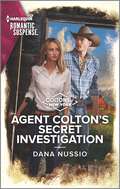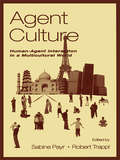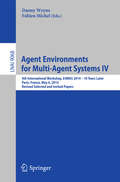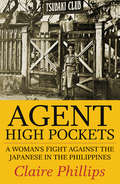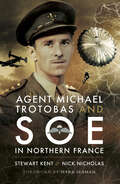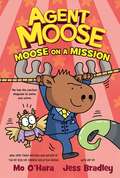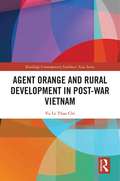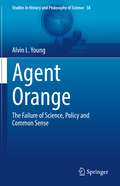- Table View
- List View
Agent Colton's Secret Investigation (The Coltons of New York #5)
by Dana NussioA rancher confronts the pastWith a fearless agent&’s help… Rancher Micah Perry always suspected his father was murdered. Now FBI agent Deirdre Colton is seeking his help investigating his former stepmother, a potential serial killer. The case is Deirdre&’s chance to redeem herself with the Bureau. But Micah wants only to protect his son and find out who is sabotaging his ranch. Working together demands they overcome their differences…and their searing attraction.From Harlequin Romantic Suspense: Danger. Passion. Drama.Feel the excitement in these uplifting romances, part of The Coltons of New York series:Book 1: Colton's Unusual Suspect by Marie FerrarellaBook 2: Protecting Colton's Baby by Tara Taylor QuinnBook 3: Colton's Body of Proof by Karen WhiddonBook 4: Colton's Undercover Seduction by Beth CornelisonBook 5: Agent Colton's Secret Investigation by Dana NussioBook 6: Under Colton's Watch by Addison FoxBook 7: Colton's Deadly Affair by Jennifer D. BokalBook 8: Chasing a Colton Killer by Deborah Fletcher MelloBook 9: Protecting Colton's Secret Daughters by Lisa ChildsBook 10: Colton's Montana Hideaway by Justine Davis
Agent Colton's Takedown (The Coltons of Grave Gulch #11)
by Beverly LongA murderer has her in his sights… But not if an intrepid agent gets his way! For months, a serial killer has been haunting FBI agent Bryce Colton&’s every waking moment. And now the lethal criminal is obsessed with Grave Gulch local Olivia Margulies. Bryce knows Olivia is the key to drawing out the town&’s terrorizer. But as the lawman works to protect her 24/7, the sparks that fly between them can&’t mask the danger that looms ever closer… From Harlequin Romantic Suspense: Danger. Passion. Drama.Feel the excitement in these uplifting romances, part of the The Coltons of Grave Gulch series:Book 1: Colton's Dangerous Liaison by Regan BlackBook 2: Colton's Killer Pursuit by Tara Taylor QuinnBook 3: Colton Nursery Hideout by Dana NussioBook 4: Colton Bullseye by Geri KrotowBook 5: Guarding Colton's Child by Lara LacombeBook 6: Colton's Covert Witness by Addison FoxBook 7: Rescued by the Colton Cowboy by Deborah Fletcher MelloBook 8: Colton K-9 Target by Justine DavisBook 9: A Colton Internal Affair by Jennifer D. BokalBook 10: Uncovering Colton's Family Secret by Linda O. JohnstonBook 11: Agent Colton's Takedown by Beverly LongBook 12: Proving Colton's Innocence by Lara Lacombe
Agent Culture: Human-agent interaction in A Multicultural World
by Robert Trappl Sabine PayrThis volume began with a workshop of the Austrian Research Institute for Artificial Intelligence held in 2001. Concerned with embodied agents as cultural objects and subjects, the book is divided into three parts. It begins by drawing attention to the cultural embeddedness of technology in general and agent design in particular, as a reminder that
Agent Daddy
by Alice SharpeHE'D QUIT THE BUREAU TO WRANGLE TWO KIDS. . . AND GOT LASSOED BY ONE BEAUTIFUL WOMANAll hell broke loose when word spread that a vengeful serial killer was headed for the Triple T ranch. Fearing the worst, former FBI agent Luke Tripper entrusted his orphaned niece and nephew to Faith Bishop's tender loving care while he hunted down his prey. Their smoldering attraction chased away the winter chill, but the fiercely independent schoolteacher bristled when the brusque cattleman ordered round-the-clock protection. Despite the looming danger, Faith's unflinching courage stirred Trip's deepest emotions. . . and he hungered to hold her close. Now with the body count rising and his loved ones in peril, would this hometown hero lay his heart on the line?
Agent Double Zero: The spoiled brat
by Yves Patrick BeaulieuPauline Bilodeau, a young Goth, is visiting her father in Rouyn-Noranda, located in the Abitibi region. She’s getting to know her stepbrother, Ovila, whom she’s meeting for the first time. She’s ready for anything except what she finds...
Agent Environments for Multi-Agent Systems IV: 4th International Workshop, E4MAS 2014 - 10 Years Later, Paris, France, May 6, 2014, Revised Selected and Invited Papers (Lecture Notes in Computer Science #9068)
by Danny Weyns Fabien MichelThis book constitutes the thoroughly refereedpost-workshop proceedings of the 4th International Workshop on Environments forMultiagent Systems, E4MAS 2014 - 10 years later, held in Paris, France, in May2014 as an associated event of AAMAS 2014, the 13th International Conference onAutonomous Agents and Multiagent Systems. The 6 revised full papers presented together with 1roadmap paper and 7 invited papers were carefully reviewed and selected from 14initial submissions. The papers are organized in topical sections on connectingagents, environments, and humans; environments for complex and stigmergicsystems; virtual and simulated environments; and open agent environments andinteroperability.
Agent Garbo: The Brilliant, Eccentric Secret Agent Who Tricked Hitler and Saved D-Day
by Stephan Talty&“The book presses ever forward down a path of historical marvels and astonishing facts. The effect is like a master class that&’s accessible to anyone, and Agent Garbo often reads as though it were written in a single, perfect draft.&”—The AtlanticBefore he remade himself as the master spy known as Garbo, Juan Pujol was nothing more than a Barcelona poultry farmer. But as Garbo, he turned in a masterpiece of deception that changed the course of World War II. Posing as the Nazis&’ only reliable spy inside England, he created an imaginary million-man army, invented armadas out of thin air, and brought a vast network of fictional subagents to life. The scheme culminated on June 6, 1944, when Garbo convinced the Germans that the Allied forces approaching Normandy were just a feint—the real invasion would come at Calais. Because of his brilliant trickery, the Allies were able to land with much less opposition and eventually push on to Berlin.As incredible as it sounds, everything in Agent Garbo is true, based on years of archival research and interviews with Pujol&’s family. This pulse-pounding thriller set in the shadow world of espionage and deception reveals the shocking reality of spycraft that occurs just below the surface of history.&“Stephan Talty&’s unsurpassed research brings forth one of the war&’s greatest agents in a must-read book for those who think they know all the great World War II stories.&” —Gregory Freeman, author of The Forgotten 500
Agent Gemini
by Lilith SaintcrowA superspy meets her match in New York Times bestselling author Lilith Saintcrow's latest romance! As a genetically enhanced assassin for a secret agency, Cal has one mission: to recapture the sultry rogue superspy who calls herself Trinity. Yet when he finds her, Cal will risk everything to keep her out of his superiors' deadly hands. Despite a computerlike brain and the ability to heal herself, Trinity has no memory of her life before the agency. She's desperate to uncover her identity. Every bit of trust she places in gorgeous, sexy Cal seems to bring back a little of her humanity. But her secrets might destroy them both, before the agency even gets a chance.
Agent High Pockets
by Claire Philips Myron B. GoldsmithAgent High Pockets, first published in 1947 as Manila Espionage, is the fast-paced account of American Claire Phillips' experiences in Manila during the Japanese occupation in World War Two (the book is also the basis for the 1951 movie I Was an American Spy,). Prior to the war, Phillips had worked in Manila as part of a musical group. She had married, separated, and returned to the US, but came back to Manila just before the Japanese invasion. She fell in love with John Phillips, a soldier, and married him just after the war broke out; her husband became a prisoner of war, but sadly, was captured and died during his imprisonment. At the urging of American guerrilla leader John Boone, she began working for the resistance movement, opening a club for Japanese officers in order to win favors from the Japanese and to be able to send financial help and messages to the prisoners of war. The club also let her obtain intelligence from the Japanese clients, which she smuggled to the guerrillas who then forwarded the information to General Douglas MacArthur’s headquarters. As a guerrilla agent, her code name was “High Pockets” as she typically kept messages in her bra. Eventually though, she was arrested and tortured by the Japanese and spent more than eight months in prison before her liberation by U.S. Forces in 1945. After the war, she and her daughter returned to the United States. In recognition for her courageous efforts in the Philippines, Claire Phillips was awarded the Medal of Freedom in 1951.
Agent In Amorous City: Volume 1 (Volume 1 #1)
by Si MaShengJieLi Shaoguang was an ordinary university student. Before graduating from university, he had accidentally saved Zhang Wuji and obtained his soul and the Nine Yang Divine Technique. His illusory martial arts combined with his declining martial arts caused a huge change in his world. Of course, it would be accompanied by a beautiful woman.
Agent In Amorous City: Volume 2 (Volume 2 #2)
by Si MaShengJieLi Shaoguang was an ordinary university student. Before graduating from university, he had accidentally saved Zhang Wuji and obtained his soul and the Nine Yang Divine Technique. His illusory martial arts combined with his declining martial arts caused a huge change in his world. Of course, it would be accompanied by a beautiful woman.
Agent Jack: The True Story of MI5's Secret Nazi Hunter
by Robert Hutton'Highly readable' Ben Macintyre'Pacy, original and frequently chilling' Henry HemmingJune 1940. Britain is Europe's final bastion of freedom - and Hitler's next target. But not everyone fears a Nazi invasion. In factories, offices and suburban homes are men and women determined to do all they can to hasten it.Throughout the Second World War, Britain's defence against the enemy within was Eric Roberts, a former bank clerk from Epsom. Equipped with an extraordinary ability to make people trust him, he was recruited into the shadowy world of espionage by the great spymaster Maxwell Knight. Roberts penetrated first the Communist Party and then the British Union of Fascists, before playing his greatest role for MI5 - as Hitler's man in London. Codenamed Jack King, he single-handedly built a network of hundreds of British Nazi sympathisers, with many passing secrets to him in the mistaken belief that he was a Gestapo officer. Operation Fifth Column, run by a brilliant woman scientist and a Jewish aristocrat with a sideline in bomb disposal, was kept so secret it was omitted from the reports MI5 sent to Winston Churchill. In a narrative that grips like a thriller, Robert Hutton tells the fascinating story of an operation whose existence has only recently come to light. Drawing on newly declassified documents and private family archives, Agent Jack shatters the comfortable notion that Britain could never have succumbed to fascism, and celebrates - at last - the courage of individuals who protected the country they loved at great personal risk.
Agent Jack: The True Story of MI5's Secret Nazi Hunter
by Robert HuttonJune 1940. Britain is Europe's final bastion of freedom - and Hitler's next target. But not everyone fears a Nazi invasion. In factories, offices and suburban homes are men and women determined to do all they can to hasten it.Throughout the Second World War, Britain's defence against the enemy within was Eric Roberts, a former bank clerk from Epsom. Equipped with an extraordinary ability to make people trust him, he was recruited into the shadowy world of espionage by the great spymaster Maxwell Knight. Roberts penetrated first the Communist Party and then the British Union of Fascists, before playing his greatest role for MI5 - as Hitler's man in London. Codenamed Jack King, he single-handedly built a network of hundreds of British Nazi sympathisers, with many passing secrets to him in the mistaken belief that he was a Gestapo officer. Operation Fifth Column, run by a brilliant woman scientist and a Jewish aristocrat with a sideline in bomb disposal, was kept so secret it was omitted from the reports MI5 sent to Winston Churchill. In a narrative that grips like a thriller, Robert Hutton tells the fascinating story of an operation whose existence has only recently come to light. Drawing on newly declassified documents and private family archives, Agent Jack shatters the comfortable notion that Britain could never have succumbed to fascism, and celebrates - at last - the courage of individuals who protected the country they loved at great personal risk.Read by Roger Davis(P) Orion Publishing Group 2018
Agent Jack: The True Story of MI5's Secret Nazi Hunter
by Robert Hutton"An appealing mix of accessibility and research. [Hutton] has illuminated a fascinating and often appalling side of the war at home." — Wall Street Journal The never-before-told story of Eric Roberts, who infiltrated a network of Nazi sympathizers in Great Britain in order to protect the country from the grips of fascismJune 1940: Europe has fallen to Adolf Hitler’s army, and Britain is his next target. Winston Churchill exhorts the country to resist the Nazis, and the nation seems to rally behind him. But in secret, some British citizens are plotting to hasten an invasion. Agent Jack tells the incredible true story of Eric Roberts, a seemingly inconsequential bank clerk who, in the guise of “Jack King”, helped uncover and neutralize the invisible threat of fascism on British shores. Gifted with an extraordinary ability to make people trust him, Eric Roberts penetrated the Communist Party and the British Union of Fascists before playing his greatest role for MI5: Hitler's man in London. Pretending to be an agent of the Gestapo, Roberts single-handedly built a network of hundreds of British Nazi sympathizers—factory workers, office clerks, shopkeepers —who shared their secrets with him. It was work so secret and so sensitive that it was kept out of the reports MI5 sent to Winston Churchill. In a gripping real-world thriller, Robert Hutton tells the fascinating story of an operation whose existence has only recently come to light with the opening of MI5’s World War II files. Drawing on these newly declassified documents and private family archives, Agent Jack shatters the comforting notion that Britain could never have succumbed to fascism and, consequently, that the world could never have fallen to Hitler. Agent Jack is the story of one man who loved his country so much that he risked everything to stand against a rising tide of hate.
Agent Josephine: American Beauty, French Hero, British Spy
by Damien LewisThe New Yorker, Best Books of 2022 Vanity Fair, Best Books of 2022 Booklist, Best Books of 2022 Singer. Actress. Beauty. Spy. During WWII, Josephine Baker, the world's richest and most glamorous entertainer, was an Allied spy in Occupied France. Prior to World War II, Josephine Baker was a music-hall diva renowned for her singing and dancing, her beauty and sexuality; she was the highest-paid female performer in Europe. When the Nazis seized her adopted city, Paris, she was banned from the stage, along with all &“negroes and Jews.&” Yet instead of returning to America, she vowed to stay and to fight the Nazi evil. Overnight, she went from performer to Resistance spy. In Agent Josephine, bestselling author Damien Lewis uncovers this little-known history of the famous singer&’s life. During the war years, as a member of the French Nurse paratroopers—a cover for her spying work—Baker participated in numerous clandestine activities and emerged as a formidable spy. In turn, she was a hero of the three countries in whose name she served—the US, France, and Britain. Drawing on a plethora of new historical material and rigorous research, including previously undisclosed letters and journals, Lewis upends the conventional story of Josephine Baker, explaining why she fully deserves her unique place in the French Panthéon.
Agent M: The Lives and Spies of MI5's Maxwell Knight
by Henry HemmingSpying is the art of knowing who to trust-and who to betrayMaxwell Knight was perhaps the greatest spymaster in history, rumored to be the real-life inspiration for the James Bond character "M." He did more than anyone in his era to combat the rising threat of fascism in Britain during World War II, in spite of his own history inside this movement. He was also truly eccentric--a thrice-married jazz aficionado who kept a menagerie of exotic pets--and almost totally unqualified for espionage.Yet he had a gift for turning practically anyone into a fearless secret agent. Knight's work revolutionized British intelligence, pioneering the use of female agents, among other accomplishments. In telling Knight's remarkable story, Agent M also reveals for the first time in print the names and stories of some of the men and women recruited by Knight, on behalf of MI5, who were asked to infiltrate the country's most dangerous political organizations.Drawing on a vast array of original sources, Agent M reveals not only the story of one of the world's greatest intelligence operators, but the sacrifices and courage required to confront fascism during a nation's darkest time.
Agent Michael Trotobas and SOE in Northern France
by Nick Nicholas Stewart KentThe exceptional exploits, courage and leadership of British SOE Agent Trotobas have long been recognised in France but not in his own country despite being recommended for the Victoria Cross.Captured on his first mission, Trotobas led a mass break-out from Mauzac Internment Camp and eventually returned to England. He immediately volunteered to return and established and ran a resistance group around Lille and the Pas de Calais for a year. As the Nazis closed in, he refused to leave the French men and women who had shown him complete loyalty. He paid the ultimate price, fighting to the death rather than undergo capture.As well as describing the operations of the Sylvestre-Farmer circuit, the authors record the rivalries and intrigues that sprang up culminating in betrayals and extraordinary demand for the court martial and execution of the Circuit's British second in command.This book is a major addition to the bibliography of the SOE and French Resistance.
Agent Moose (Agent Moose #1)
by Mo O'HaraAgent Moose, the best (worst) secret agent in the Big Forest, and his slightly-more-intelligent sidekick Owlfred are on the case in this new full color graphic novel chapter book series from Mo O'Hara, author of My Big Fat Zombie Goldfish, illustrated by Jess Bradley! Something fishy is going on at the South Shore. Folks just disappear and are never seen again. But when Agent Moose learns that a key witness has gone missing, he and Owlfred ride to the rescue. Will they find the missing turtle before time runs out?
Agent Moose: Moose on a Mission (Agent Moose #2)
by Mo O'HaraSomeone is putting the squeeze on the animals of the Big Forest, and there’s only one moose who can help in Agent Moose: Moose on a Mission, the second hilarious graphic novel chapter book from Mo O'Hara, the New York Times bestselling author of My Big Fat Zombie Goldfish! Agent Moose, the best (worst) secret agent at Woodland HQ, and his slightly-more-intelligent sidekick, Owlfred, are on the case again! There’s big news in the Big Forest! The circus is in town, Granny Moose is coming to visit, and a mysterious robber is on the loose. When Agent Moose learns that someone is putting the squeeze on innocent animals, he and Owlfred rush to investigate, with Granny along for the ride! Can they solve this mystery before any more animals face the big squeeze?
Agent Moose: Operation Owl (Agent Moose #3)
by Mo O'HaraA daring criminal is making waves in the Big Forest! It’s up to Agent Moose and Owlfred to save the day in Operation Owl, the third hilarious graphic novel chapter book from Mo O’Hara, the author of My Big Fat Zombie Goldfish, with illustrations by Jess Bradley.Agent Moose and not-quite-so-special Agent Owlfred are back and better than ever! Strange flash floods are making waves (and headlines) all over the Big Forest! Someone is pulling off particularly confounding capers and, between the flooding and the heists, Big Forest is in big trouble. When Madame HQ is nabbed right out of a very wet Woodland HQ, Agent Moose and Owlfred must wade through clues to get her back and stop the mystery criminal making a big splash in Big Forest! Can they find this fiendish villain before Big Forest floats away?
Agent Most Wanted: The Never-Before-Told Story of the Most Dangerous Spy of World War II
by Sonia PurnellA young readers adaptation of Sonia Purnell's New York Times bestselling book A Woman of No Importance, the story of Virginia Hall; the unassuming American spy who helped the allies win World War II.Virginia Hall was deemed "the most dangerous of all allied spies" by the Gestapo. Armed with her wits and her prosthetic leg, she was deployed behind enemy lines to inspire resistance in France, providing crucial support to fighting the Nazi occupation. In this largely untold story, Sonia Purnell uncovers the truth behind a Baltimore socialite who was essential to allied victory.Adapted for the elementary to middle school audience audience, Agent Most Wanted is equal parts an inspiring tale of feminism in a time when women weren't taken seriously, an epic spy story, and, of course, a retelling of winning one of the largest global conflicts in modern history.
Agent Orange and Rural Development in Post-war Vietnam (Routledge Contemporary Southeast Asia Series)
by Vu Le Thao ChiVu tells the story of Vietnamese farmers who have survived a 30-year war of independence and unification, its damaging legacies in their living environment, and the unfamiliar pressure of the market economy. Vietnamese famers are neither simply obedient beneficiaries of policy decisions made by higher authorities nor convention-ridden cyphers. Rather, they are sophisticated decision-makers capable of navigating the changes threatening to disrupt their lives over multiple generations. Vu’s research pays particular attention to those farmers whose families have suffered from direct and indirect exposure to the toxic herbicides popularly known as Agent Orange. She demonstrates that their priority has tended to be the protection of their existing assets, rather than pursuing the promise of new riches, and that this tendency has helped them maintain stability in a turbulent economic environment. A fascinating study for scholars of Vietnamese anthropology and society, the book will also be of interest to sociologists and economists with a broader interest in the impact of economic and political change on rural lifestyles.
Agent Orange: History, Science, and the Politics of Uncertainty
by Edwin A. MartiniTaking on what one former U.S. ambassador called "the last ghost of the Vietnam War," this book examines the far-reaching impact of Agent Orange, the most infamous of the dioxin-contaminated herbicides used by American forces in Southeast Asia. Edwin A. Martini's aim is not simply to reconstruct the history of the "chemical war" but to investigate the ongoing controversy over the short- and long-term effects of weaponized defoliants on the environment of Vietnam, on the civilian population, and on the troops who fought on both sides. Beginning in the early 1960s, when Agent Orange was first deployed in Vietnam, Martini follows the story across geographical and disciplinary boundaries, looking for answers to a host of still unresolved questions. What did chemical manufacturers and American policymakers know about the effects of dioxin on human beings, and when did they know it? How much do scientists and doctors know even today? Should the use of Agent Orange be considered a form of chemical warfare? What can, and should, be done for U.S. veterans, Vietnamese victims, and others around the world who believe they have medical problems caused by Agent Orange? Martini draws on military records, government reports, scientific research, visits to contaminated sites, and interviews to disentangle conflicting claims and evaluate often ambiguous evidence. He shows that the impact of Agent Orange has been global in its reach affecting individuals and communities in New Zealand, Australia, Korea, and Canada as well as Vietnam and the United States. Yet for all the answers it provides, this book also reveals how much uncertainty--scientific, medical, legal, and political--continues to surround the legacy of Agent Orange.
Agent Orange: The Failure of Science, Policy and Common Sense (Studies in History and Philosophy of Science #58)
by Alvin L. YoungThis book tells the story of Agent Orange, its usage and the policies that surround it. Agent Orange contains a contaminant known as TCDD. It was the most widely used defoliant from 1965 – 1970 and became one of three major tactical herbicides used in Vietnam. More than 45 major health studies were conducted with Vietnam veterans from the United States, Australia, New Zealand, and Korea seeking a relationship between veterans’ health and TCDD. Allegations of birth defects in the families of Vietnam veterans and the Vietnamese represented a case study in propaganda and deliberate misinformation by the government of Vietnam. The Policies of the US Government implemented by Congress and the Department of Veterans Affairs (DVA) identified 17 recognized associated presumptive diseases that failed the tests of “cause and effect” and common sense. This book tells the story of Agent Orange, its usage, the health studies and those policies from a diverse range of perspectives, delving into science, statistics, history, policy and ethics. It is of interest to scholars engaged in history, political and social philosophy and ethics.
Agent Out
by Francine PascalCatherine is dead. At least that's what the FBI claims. They say there's no point investigating the strange disappearance any further. Instead they want Gaia to stay in Quantico to carry on the search for the Lollipop Murderer. Gaia is convinced her partner is still alive -- and that she needs help. Even if it means putting the murder case on hold, Gaia must go after her. But going AWOL means losing the support of the FBI. Gaia will be completely on her own and heading into danger. Because Catherine's abduction is far more complicated -- and more sinister -- than she realized. In fact, it's a whole new mystery.
